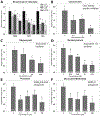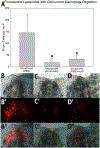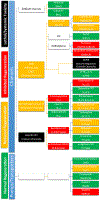Ion channel signaling influences cellular proliferation and phagocyte activity during axolotl tail regeneration
- PMID: 28603004
- PMCID: PMC6386162
- DOI: 10.1016/j.mod.2017.06.001
Ion channel signaling influences cellular proliferation and phagocyte activity during axolotl tail regeneration
Abstract
Little is known about the potential for ion channels to regulate cellular behaviors during tissue regeneration. Here, we utilized an amphibian tail regeneration assay coupled with a chemical genetic screen to identify ion channel antagonists that altered critical cellular processes during regeneration. Inhibition of multiple ion channels either partially (anoctamin1/Tmem16a, anoctamin2/Tmem16b, KV2.1, KV2.2, L-type CaV channels and H/K ATPases) or completely (GlyR, GABAAR, KV1.5 and SERCA pumps) inhibited tail regeneration. Partial inhibition of tail regeneration by blocking the calcium activated chloride channels, anoctamin1&2, was associated with a reduction of cellular proliferation in tail muscle and mesenchymal regions. Inhibition of anoctamin 1/2 also altered the post-amputation transcriptional response of p44/42 MAPK signaling pathway genes, including decreased expression of erk1/erk2. We also found that complete inhibition via voltage gated K+ channel blockade was associated with diminished phagocyte recruitment to the amputation site. The identification of H+ pumps as required for axolotl tail regeneration supports findings in Xenopus and Planaria models, and more generally, the conservation of ion channels as regulators of tissue regeneration. This study provides a preliminary framework for an in-depth investigation of the mechanistic role of ion channels and their potential involvement in regulating cellular proliferation and other processes essential to wound healing, appendage regeneration, and tissue repair.
Copyright © 2017 Elsevier B.V. All rights reserved.
Figures









Similar articles
-
Histone deacetylases are required for amphibian tail and limb regeneration but not development.Mech Dev. 2012 Sep-Dec;129(9-12):208-18. doi: 10.1016/j.mod.2012.08.001. Epub 2012 Aug 26. Mech Dev. 2012. PMID: 22947425
-
Using Ambystoma mexicanum (Mexican axolotl) embryos, chemical genetics, and microarray analysis to identify signaling pathways associated with tissue regeneration.Comp Biochem Physiol C Toxicol Pharmacol. 2015 Dec;178:128-135. doi: 10.1016/j.cbpc.2015.06.004. Epub 2015 Jun 16. Comp Biochem Physiol C Toxicol Pharmacol. 2015. PMID: 26092703 Free PMC article.
-
Amputation-induced reactive oxygen species signaling is required for axolotl tail regeneration.Dev Dyn. 2019 Feb;248(2):189-196. doi: 10.1002/dvdy.5. Epub 2018 Dec 21. Dev Dyn. 2019. PMID: 30569660 Free PMC article.
-
Exploring the role of microRNAs in axolotl regeneration.J Cell Physiol. 2021 Feb;236(2):839-850. doi: 10.1002/jcp.29920. Epub 2020 Jul 7. J Cell Physiol. 2021. PMID: 32638401 Review.
-
The physiological roles of anoctamin2/TMEM16B and anoctamin1/TMEM16A in chemical senses.Cell Calcium. 2024 Jun;120:102889. doi: 10.1016/j.ceca.2024.102889. Epub 2024 Apr 18. Cell Calcium. 2024. PMID: 38677213 Review.
Cited by
-
Biomedical applications of electrical stimulation.Cell Mol Life Sci. 2020 Jul;77(14):2681-2699. doi: 10.1007/s00018-019-03446-1. Epub 2020 Jan 23. Cell Mol Life Sci. 2020. PMID: 31974658 Free PMC article. Review.
-
Novelty of harnessing electromagnetic fields to boost graphene oxide nano particles antibacterial potency.Sci Rep. 2025 Mar 19;15(1):9524. doi: 10.1038/s41598-025-91408-y. Sci Rep. 2025. PMID: 40108229 Free PMC article.
-
Post-amputation reactive oxygen species production is necessary for axolotls limb regeneration.Front Cell Dev Biol. 2022 Aug 26;10:921520. doi: 10.3389/fcell.2022.921520. eCollection 2022. Front Cell Dev Biol. 2022. PMID: 36092695 Free PMC article.
-
Salamander-like tail regeneration in the West African lungfish.Proc Biol Sci. 2020 Sep 30;287(1935):20192939. doi: 10.1098/rspb.2019.2939. Epub 2020 Sep 16. Proc Biol Sci. 2020. PMID: 32933441 Free PMC article.
-
Amputation Triggers Long-Range Epidermal Permeability Changes in Evolutionarily Distant Regenerative Organisms.bioRxiv [Preprint]. 2024 Aug 31:2024.08.29.610385. doi: 10.1101/2024.08.29.610385. bioRxiv. 2024. PMID: 39257748 Free PMC article. Preprint.
References
-
- Adams DS, Masi A, Levin M, 2007. H+ pump-dependent changes in membrane voltage are an early mechanism necessary and sufficient to induce Xenopus tail regeneration. Development 134 (7), 1323–1335. - PubMed
-
- Baddar NWAH, et al., 2015. Sal-site: research resources for the Mexican Axolotl In: Kumar A, Simon A (Eds.), Salamanders in Regeneration Research: Methods and Protocols. Springer New York, New York, NY, pp. 321–336. - PubMed
-
- Balestrini L, et al., 2017. The natural compound sanguinarine perturbs the regenerative capabilities of planarians. Int. J. Dev. Biol 61 (1–2), 43–52. - PubMed
Publication types
MeSH terms
Substances
Grants and funding
LinkOut - more resources
Full Text Sources
Other Literature Sources
Miscellaneous

